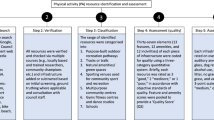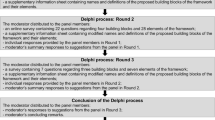Abstract
OBJECTIVE: Municipal policies may have a significant impact on the development of environments that provide sustainable opportunities for individuals to engage in healthy, active lifestyles. Little is known about how explicitly community planning in Canada integrates strategies to promote physical activity. In the context of Active Saskatchewan 2020 (AS2020), the strategic plan of Saskatchewan in motion, such an analysis would create a basis for identifying policy gaps and ongoing monitoring. The objective of this study was to review the official community plan (OCP) of each city in the province of Saskatchewan, Canada and identify policies supportive of physical activity.
METHODS: A conventional content analysis was completed of the OCPs of the 17 cities in Saskatchewan. Each OCP was reviewed and text extracted that related to supporting physical activity. Extracted text was thematically organized within and across cities, creating a set of indicators for ongoing monitoring.
RESULTS: Overall, 17 indicators were identified. The frequency of inclusion of these indicators within the 17 OCPs varied from 17.6% to 82.4%. The mean frequency of indicators identified per OCP was 7.4. The most commonly included indicators included residential neighbourhood plans associated with active living, downtown cycling and pedestrian plans, and joint-use agreements between communities and schools.
CONCLUSIONS: Most Saskatchewan OCPs make little direct reference to policies supportive of physical activity. Impacting community-level policy is an expected outcome of AS2020/Saskatchewan in motion. This study identifies a range of indicators for monitoring this process and highlights potential areas for policy development within OCPs.
Résumé
OBJECTIF: Les politiques municipales peuvent avoir des incidences considérables sur le développement de milieux offrant aux particuliers des possibilités durables de pratiquer des modes de vie sains et actifs. On ignore en général si la planification urbaine au Canada intègre explicitement des stratégies pour favoriser l’activité physique. Dans le contexte d’Active Saskatchewan 2020 (AS2020), le plan stratégique de Saskatchewan in motion, une telle analyse permettrait de déceler les lacunes dans les politiques et d’exercer une surveillance continue. Notre étude visait à examiner le plan d’urbanisme officiel (PUO) de chacune des villes de la province de la Saskatchewan, au Canada, pour y repérer les politiques propices à l’activité physique.
MÉTHODE: Nous avons effectué une analyse de contenu classique des PUO des 17 villes de la Saskatchewan. Nous avons examiné chaque PUO pour en extraire les passages ayant un lien avec le soutien de l’activité physique. Nous avons classé ces extraits par thème pour chaque ville et pour différentes villes, créant ainsi un jeu d’indicateurs pour l’exercice d’une surveillance continue.
RÉSULTATS: Globalement, 17 indicateurs ont été établis. La fréquence d’inclusion de ces indicateurs dans les 17 PUO variait entre 17,6 % et 82,4 %. La fréquence moyenne des indicateurs recensés était de 7,4 par PUO. Les indicateurs les plus communément utilisés étaient les plans de quartiers résidentiels associés à la vie active, les plans du réseau cyclable et piétonnier du centre-ville et les ententes d’utilisation commune entre les communautés et les écoles.
CONCLUSIONS: Dans la plupart des PUO de la Saskatchewan, il est rare que des politiques propices à l’activité physique soient directement mentionnées. AS2020 et Saskatchewan in motion auront probablement un effet sur les politiques d’urbanisme. Notre étude établit un jeu d’indicateurs pour surveiller ce processus et souligne les aspects qu’il serait possible d’améliorer en élaborant des politiques à intégrer dans les PUO.
Similar content being viewed by others
References
Hallal PC, Andersen LB, Bull FC, Guthold R, Haskell W, Ekelund U, for the Lancet Physical Activity Series Working Group. Global physical activity levels: Surveillance progress, pitfalls, and prospects. Lancet 2012;380(9838):230–37. PMID: 22818937. doi: 10.1016/S0140-6736(12)60646-1.
Kohl HW 3rd, Craig CL, Lambert EV, Inoue S, Alkandari JR, Leetongin G, et al., for the Lancet Physical Activity Series Working Group. The pandemic of physical inactivity: Global action for public health. Lancet 2012; 380(9838):294–305. PMID: 22818941. doi: 10.1016/S0140-6736(12)60898-8.
ParticipACTION. Are Canadian Kids Too Tired to Move? The 2016 PartitipACTION Report Card on Physical Activity for Children and Youth, Toronto, ON: ParticipACTION, 2016.
World Health Organization. Global Recommendations on Physical Activity for Health. Geneva, Switzerland: WHO, 2010. Available at: http://www.who.int/dietphysicalactivity/publications/9789241599979/en/ (Accessed September 29, 2016).
Saskatchewan in motion. Physical Activity by the Numbers. Regina, SK: Saskatchewan in motion, 2015. Available at: http://www.saskatchewaninmotion.ca/issues/physical-activity-by-the-numbers (Accessed September 29, 2016).
Statistics Canada, Health Reports. Physical Activity of Canadian Adults: Accelerometer Results From 2007 to 2009 Canadian Health Measures Survey. Ottawa, ON: Statistics Canada, 2011. Available at: www.statcan.gc.ca/pub/82-003-x/2011001/article/11396-eng.htm (Accessed September 29, 2016).
Statistics Canada, Canadian Community Health Survey (CCHS). Percentage at Least Moderately Active in Leisure-Time, by Province or Territory, Household Population Aged 12 or Older, Canada, 2005. Ottawa, ON: Statistics Canada, 2007. Available at: http://www.statcan.gc.ca/pub/82-003-x/2006008/article/phys/c-g/4060706-eng.htm (Accessed September 29, 2016).
Statistics Canada, Health Fact Sheets. Overweight and Obese Adults (Self-Reported), 2014. Ottawa, ON: Statistics Canada, 2015. Available at: http://www.statcan.gc.ca/pub/82-625-x/2015001/article/14185-eng.htm (Accessed September 29, 2016).
Corbin CB, Welk GJ, Corbin WR, Welk KA. Concepts of Physical Fitness: Active Lifestyles for Wellness, 17th ed. [place of publication]. New York, NY: The McGraw-Hill Companies, Inc., 2013; 351–57.
Litt JS, Reed HL, Tabak RG, Zieff SG, Eyler AA, Lyn R, et al. Active living collaboratives in the United States: Understanding characteristics, activities, and achievement of environmental and policy change. Prev Chronic Dis 2013; 10(E19):1–14. PMID: 23391295. doi: 10.5888/pcdl0.120162.
Besser LM, Dannenberg AL. Walking to public transit: Steps to help meet physical activity recommendations. Am J Prev Med 2005;29(4):273–80. PMID: 16242589. doi: 10.1016/j.amepre.2005.06.010.
Lachapelle U, Frank L, Saelens BE, Sallis JF, Conway TL. Commuting by public transit and physical activity: Where you live, where you work, and how you get there. J Phys Act Health 2011;8(Suppl 1):S72–82. PMID: 21350265. doi: 10. 1123/jpah.8.s1.s72.
Saelens BE, Sallis JF, Frank LD. Environmental correlates of walking and cycling: Findings from the transportation, urban design, and planning literatures. Ann Behav Med 2003;25(2):80–91. PMID: 12704009. doi: 10. 1207/S15324796ABM2502_03.
Durand CP, Andalib M, Dunton GF, Wolch J, Pentz MA. A systematic review of built environmental factors related to physical activity and obesity risk: Implications for smart growth urban planning. Obes Rev 2011;12:e173–82. PMID: 21348918. doi: 10.1111/j.1467-789X.2010.00826.X.
Wong BYM, Faulkner G, Buliung R, Irving H. Mode shifting in school travel mode: Examining the prevalence and correlates of active school transport in Ontario, Canada. BMC Public Health 2011;11(618):1–12. PMID: 21812976. doi: 10.1186/1471-2458-11-618.
Faulkner GEJ, Buliung RN, Flora PK, Fusco C. Active school transport, physical activity levels and body weight of children and youth: A systematic review. Prev Med 2009;48(1):3–8. PMID: 19014963. doi: 10.1016/j.ypmed.2008.10. 017.
Kaczynski AT, Henderson KA. Parks and recreation settings and active living: A review of associations with physical activity function and intensity. J Phys Act Health 2008;5(4):619–32. PMID: 18648125. doi: 10.1123/jpah.5.4.619.
Schilling JM, Gilles-Corti B, Sallis JF. Connecting active living research and public policy: Transdisciplinary research and policy interventions to increase physical activity. J Public Health Policy 2009;30(Suppl 1):S1–15. PMID: 19190567. doi: 10.1057/jphp.2008.59.
Saskatchewan in motion. Active Saskatchewan 2020. Regina, SK: Saskatchewan in motion, 2015. Available at: http://www.saskatchewaninmotion.ca/about-us/our-story (Accessed January 9, 2017).
Crammond B, Gemma C. What is policy and where do we look for it when we want to research it? J Epidemiol Community Health 2017;71(4):404–8. PMID: 27864323. doi: 10.1136/jech-2016-207945.
Saskatchewan Ministry of Municipal Affairs. Official Community Plans: Preparation of an OCP. Saskatoon, SK: Saskatchewan Ministry of Municipal Affairs, 2011. Available at: http://publications.gov.sk.ca/documents/313/97950-Preparation-Official-Community-Plan.pdf (Accessed May 11, 2017).
Rudolph L, Caplan J, Ben-Moshe K, Dillon L. Health in All Policies: A Guide for State and Local Governments. Washington, DC: American Public Health Association, 2013.
Collins PA. Examining municipal government uptake of health inequities discourse: An analysis of official community plans of five metro Vancouver municipalities. Can J Urban Res 2014;23(Suppl 1):21–45.
Hsieh HF, Shannon SE. Three approaches to qualitative content analysis. Qual Health Res 2005;15(9):1277–88. PMID: 16204405. doi: 10.1177/1049732305276687.
Arbour-Nicitopoulos K, Faulkner GEJ, Buliung RN, Lay J, Stone M. The school run: Exploring carpooling as an intervention option in the Greater Toronto and Hamilton Area (GTHA), Canada. Transp Policy 2012;21:134–40. doi: 10. 1016/j.tranpol.2012.03.004.
Frank LD, Kershaw SE, Chapman JE, Campbell M, Swinkels H. The unmet demand for walkability: Disparities between preferences and actual choices for residential environments in Toronto and Vancouver. Can J Public Health 2015;106(Suppl 1):eS12–20. PMID: 25955542. doi: 10.17269/c]ph.l06.4397.
Kaczynski AT, Henderson KA. Environmental correlates of physical activity: A review of evidence about parks and recreation. Leisure Sci 2007;29(4):315–54. doi: 10.1080/01490400701394865.
Ding D, Sallis JF, Kerr J, Lee S, Rosenberg DE. Neighbourhood environment and physical activity among youth: A review. Am J Prev Med 2011;41(4): 442–55. PMID: 21961474. doi: 10.1016/j.amepre.2011.06.036.
Buliung R, Faulkner G, Beesley T, Kennedy J. School travel planning: Mobilizing school and community resources to encourage active school transportation. J Sch Health 2011;81(11):704–12. PMID: 21972991. doi: 10. 1111/j.1746-1561.2011.00647.X.
Mammen G, Faulkner G, Buliung R, Lay J. Understanding the drive to escort: A cross-sectional analysis examining parental attitudes towards children’s school travel and independent mobility. BMC Public Health 2012;12(862): 1–12. PMID: 23051005. doi: 10.1186/1471-2458-12-862.
Mitra R, Buliung RN. Built environment correlates of active school transportation: Neighborhood and the modifiable areal unit problem. J Transp Geo 2012;20(1):51–61. doi: 10.1016/j.jtrangeo.2011.07.009.
Author information
Authors and Affiliations
Corresponding author
Additional information
Acknowledgement: We would like to acknowledge research assistant Lauren White from the University of Toronto, who was the secondary reviewer of the OCPs.
Conflict of Interest: None to declare.
Rights and permissions
About this article
Cite this article
Hassan, O.B., Herman, K.M., Kryzanowski, C.D. et al. Active living in Saskatchewan: A review of official community plans. Can J Public Health 108, e551–e557 (2017). https://doi.org/10.17269/CJPH.108.6068
Received:
Accepted:
Published:
Issue Date:
DOI: https://doi.org/10.17269/CJPH.108.6068




